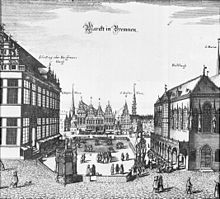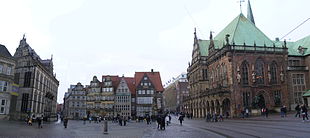



The Bremer Marktplatz (Bremen Market Square) is a square situated in the centre of the Hanseatic City of Bremen. One of the oldest public squares in the city, it covers an area of 3,484 m2 (37,500 sq ft). It is no longer used as a market place except for the Christmas market and the annual Freimarkt Fair at the end of October.



At least parts of the market place had been in function since the age of Charlemagne. Its southern side originally was the bank of river Balge (river), a branch of the Weser and Bremen's first port. There was an easy access for boats, but this section of the bank was too low for permanent buildings. From late 12th to late 13th century, the area of the market place was levelled and plastered in several stages. Theories that before the construction of the Bremen Town Hall in 1405 to 1410 all or only most of the market activities took place near Liebfrauenkirche have been falsified by archeological findings. Meantime with the townhall, Roland Statue was erected on the market square. Some time later, a stone wall was built between the inner and the outer areas of the square. The inner space was used for the market. A rule was made which allowed only merchants whose vehicles could pass one of the seven openings in the wall to sell their products. The city council made this rule in order to ensure that there was sufficient space for pedestrians between the market stalls.[1]
In the end of the 18th or beginning of the 19th century, the wall was removed and replaced by a circle of columns. At the same time, the market place lost its outstanding importance as a centre of trade and commerce even though it continued to be used as a market until mid 20th century. In 1836, the square was repaved with sandstone. Inside the circle of columns, darker stones depicted a wheel with 10 spokes. At centre of the wheel, reddish stones form a Hanseatic Cross. With a diameter of 4.8 m (16 ft), it commemorates the importance of the Hanseatic Legion during the Wars of Liberation (1813-1815). Between February and June 2002, the pavement was renewed without changing its historical layout.

The building ensemble which flanks the Marktplatz is considered one of the most beautiful in Germany. In July 2004, the part consisting of the Roland Statue and the Town Hall was listed as a UNESCO World Heritage Site. Sandstone and brick are uniformly used for the façades of the buildings.[2]
Many objects of historical interest surround the Marktplatz. The entire complex is listed as a heritage site.[3]
53°4′32″N 8°48′25″E / 53.07556°N 8.80694°E / 53.07556; 8.80694
| International |
|
|---|---|
| National |
|